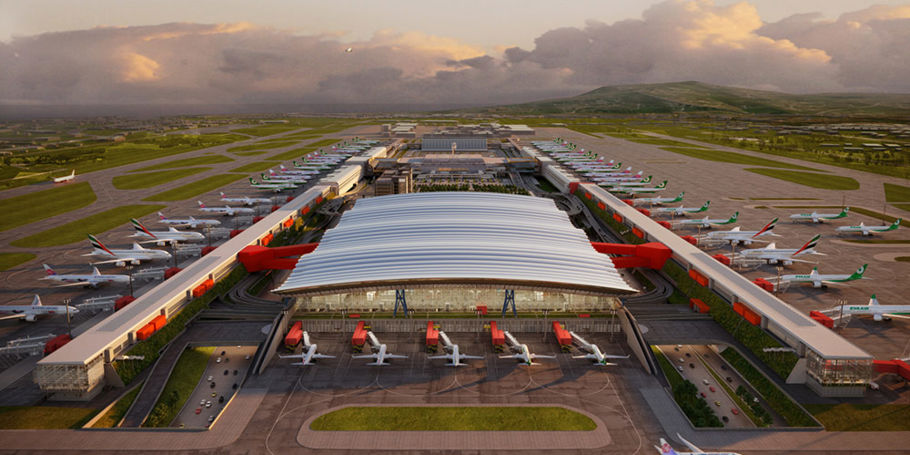Narita International Airport (NRT), a vital Asia-Pacific hub connecting 102 cities, serves as Japan’s primary international gateway. The surrounding region, rich in natural and cultural assets and in close proximity to the 40 million residents of the Greater Tokyo Area, holds substantial growth potential. The ‘New Narita Airport’ expansion project, set to unify terminals and introduce a third runway by 2029, will nearly double capacity, leading to a need for 40,000 additional local employees.
Leveraging this expansion, the Narita Airport City (NAC) initiative aims to drive regional economic growth, reinvigorate investment in technology and innovation in Japan, and address challenges such as an aging population and workforce shortages.
In alignment with this vision, we developed a strategic spatial and economic masterplan, coupled with a comprehensive socio-economic and spatial strategy. Before developing the spatial plan, we focused on attracting in industries that would generate foreign investment, grow household incomes, and upskill local workforce.
The masterplan aims to invigorate the local economy, foster synergy, spur industry innovation and rejuvenate the demographics through the agglomeration of knowledge facilities, modern industries and attractive residential zones surrounding the airport. This concept positions the area to evolve into a connected, revitalised and future-ready community that supports long-term prosperity.
This mixed-use, globally competitive airport city, is designed to balance economic growth with local livelihoods, culture and environmental sustainability. It is poised to generate new business and investment opportunities, enhancing Japan’s global competitiveness and strengthening regional connectivity. Our strategy integrates development areas across the nine towns and cities surrounding NRT. Incorporating living, working, leisure and nature, NAC is well-connected to the region, supporting both the airport and local communities.
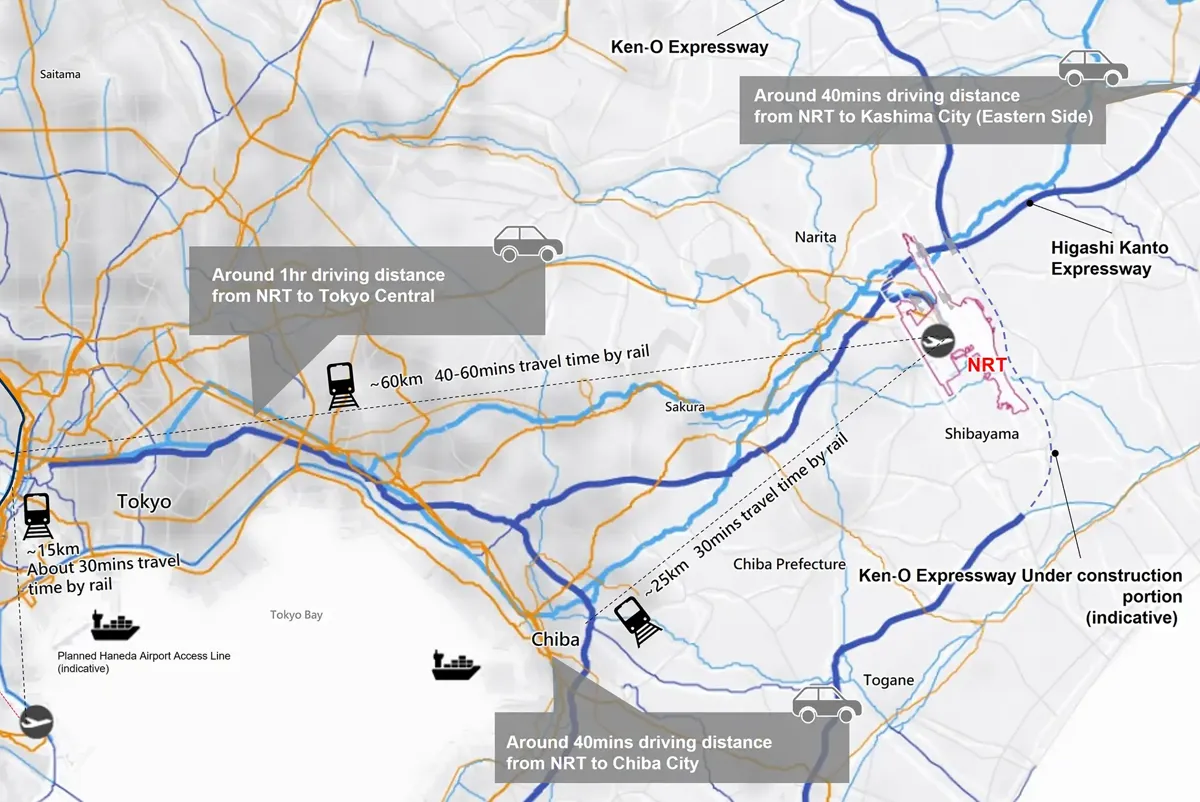
Our strategy integrates development areas across the nine towns and cities surrounding Narita International Airport (NRT).
Masterplanning balanced growth
We developed the NAC concept masterplan to stimulate the hinterland economy, promote synergy, innovation and rejuvenation by amalgamating knowledge, industries and housing around NRT, and attracting in foreign capital and know-how to catalyse skills and productivity uplift. Connecting nine towns and cities, our strategy ensures balanced growth for the airport and surrounding communities, blending living, working, leisure and nature seamlessly.
Development nodes strategically located in areas with existing infrastructure and minimal constraints optimise opportunities while minimising environmental impact. A proposed new rail station aims to enhance accessibility to the Tokyo Metropolitan Region, while an expanded public transport network will bolster connectivity within and beyond NAC.
Our plan underscores the incorporation of world-class amenities, a welcoming environment and additional community facilities for local and global talent. By integrating agricultural landscapes, topographic features and waterways into the urban fabric, we will establish a central green/blue corridor network that promotes active mobility and wellbeing.
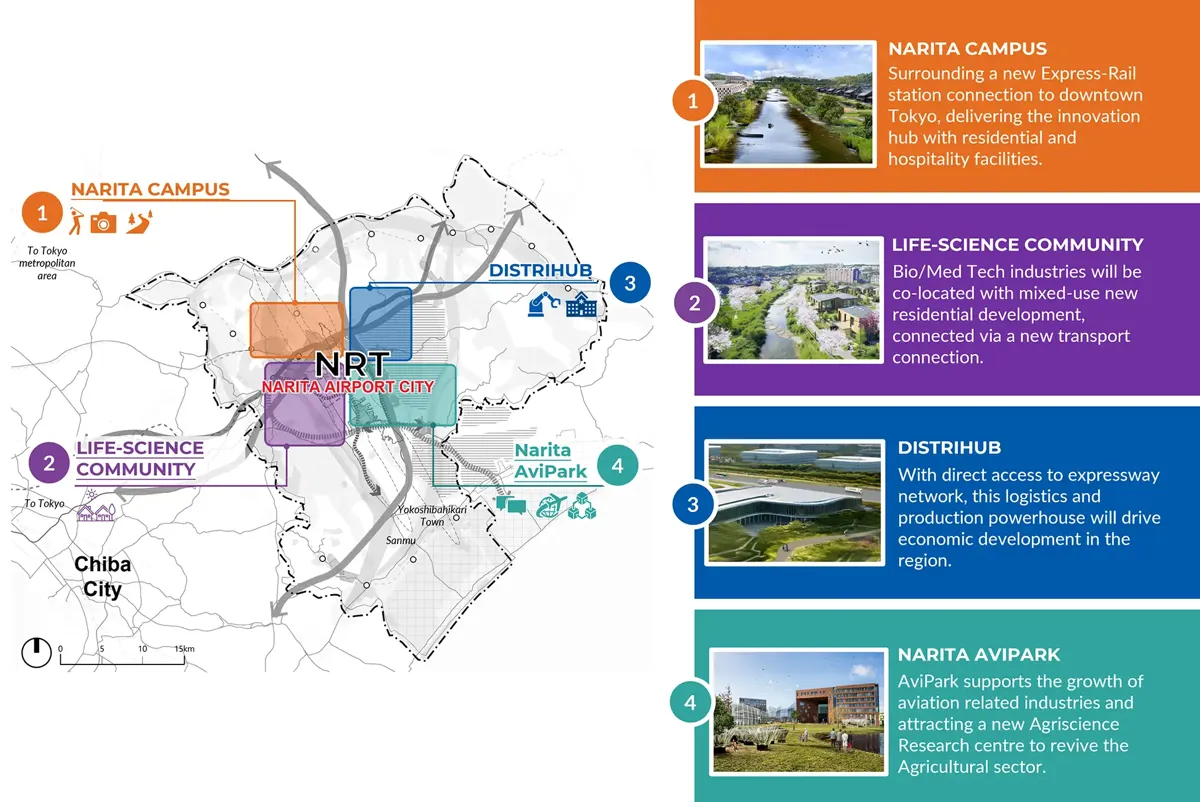
Connecting nine towns and cities, our strategy ensures balanced growth for the airport and surrounding communities, blending living, working, leisure and nature seamlessly.

By integrating agricultural landscapes, topographic features and waterways into the urban fabric, we will establish a central green/blue corridor network that promotes active mobility and wellbeing.
Embracing heritage and innovation
As a foundational strategy, NAC guides future discussions, consolidates emerging opportunities and supports marketing efforts both nationally and internationally. By positioning NAC as a globally competitive hub, our masterplan ensures sustainable development that aligns with the needs of both business and community.
At the heart of this vision lies ‘heritage and innovation’, honouring the region’s cultural and historical significance while embracing modern advancements. This concept rests on four key pillars: creating vibrant communities with aspirational living and employment opportunities, establishing a leading aviation innovation hub in East Asia, developing a distinct tourism destination beyond Tokyo and fostering a life sciences cluster propelling technology and sustainability forward.
Defining success
At the outset of the study, our focus was on creating an attractive alternative to Greater Tokyo Area’s dense urban landscape through airport city development. We aimed to benefit existing communities, reduce environmental impact, rejuvenate the declining agricultural sector, drive industry innovation and attract investment, aligning with the government’s objectives. We identified 55 key performance indicators to guide the masterplan within a strategic framework.
As NAC emerges as a vital economic driver for the region, our proposed enhancements include:
- Revitalising the local community with essential government services and infrastructure, potentially partnering with the private sector.
- Promoting sustainable development, including net-zero targets and agritech opportunities, to enhance farming productivity.
- Stimulating investment in human capital, start-ups, green technologies and digital innovations to create jobs and spur productivity growth.
- Attracting tourists by providing a hub connecting to various destinations, fostering exploration of local areas.


We identified 55 key performance indicators to guide the masterplan within a strategic framework.
Economic positioning
The economic positioning analysis for the future NAC evaluates key sectors, value chains and major players and aligns them to government growth objectives. By estimating sector potential, it provides development recommendations in line with NAC’s goals, global trends and its unique locational advantages.
Captured in a regional masterplan, NAC aims to establish a self-sufficient mixed-use development. It offers an attractive alternative to Tokyo’s urban density, diverse and international services and facilities to attract domestic and foreign talent, create high-value job opportunities, revitalise agriculture and serve as a springboard for tourists to explore the region.
The masterplan identifies constraints such as airport-related restrictions, the integration of cultural sites, agricultural activities and hazardous areas. However, opportunities lie in expanding the region’s multimodal transport network, improving access to tourism assets and leveraging natural attractions. The study highlights significant upside potential in life sciences (agritech, medtech and electronics), aviation (cargo, MRO – maintenance, repair and overhaul and training) and tourism.
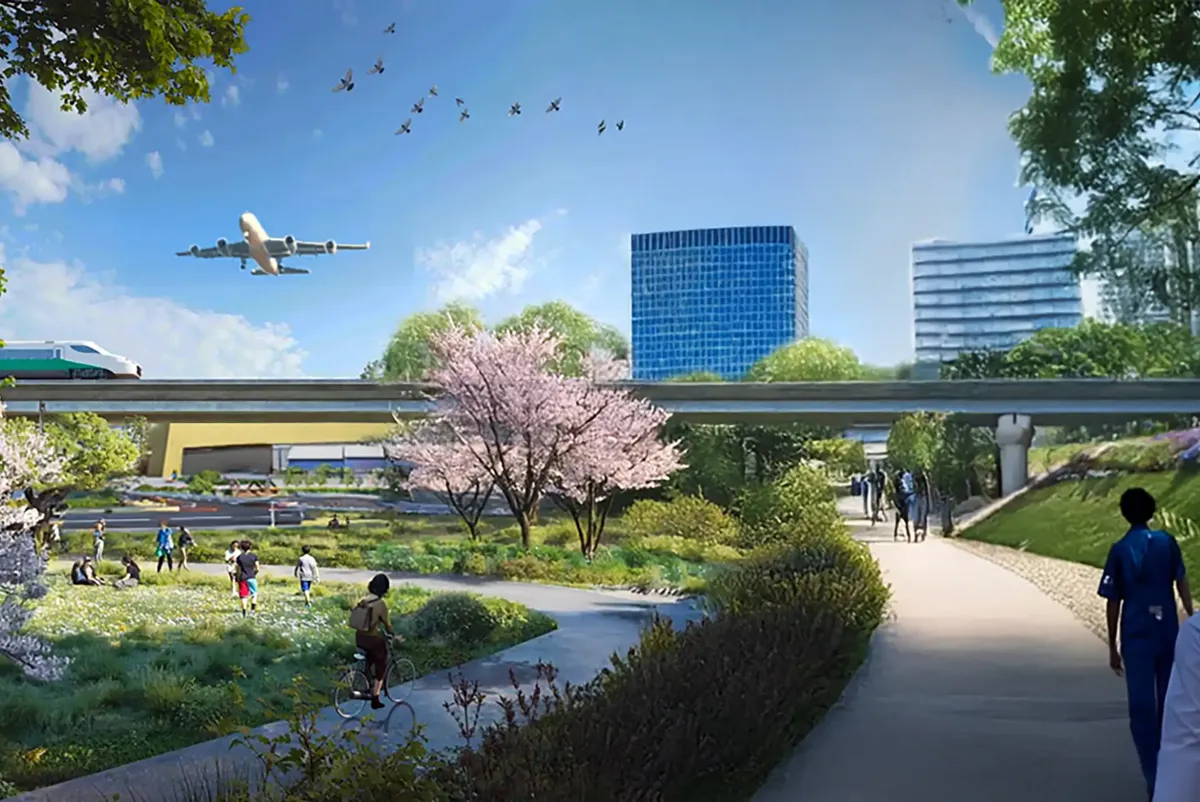
Our masterplan ensures sustainable development that aligns with the needs of both business and community.
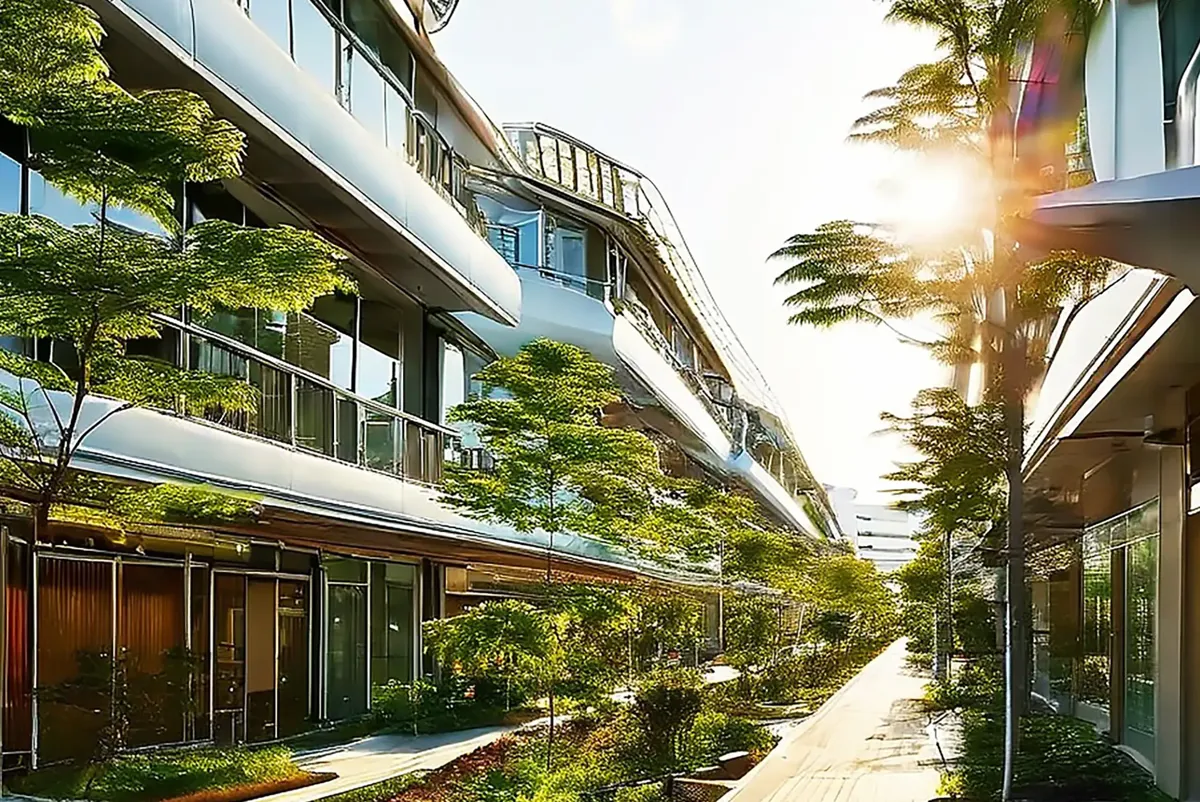
Captured in a regional masterplan, NAC aims to establish a self-sufficient mixed-use development.
For us, this NAC project is a huge project, the likes of which we have never experienced before, and we are very encouraged by Arup's extensive knowledge of the global aviation industry and urban planning.
Narita International Airport Corporation
What we delivered
-
Conducted extensive economic positioning analysis, evaluating value chains and key sectors, to inform the spatial development plan
-
Proposed strategic developments to expand capacity at the airport while balancing growth, local livelihoods, cultural heritage, and environmental sustainability
-
Developed a sustainable masterplan for Narita Airport City, boosting internationalisation, local businesses, tourism and economic growth
Get in touch with our team
Projects
Explore more aviation projects:

Helping London Gatwick assess carbon emissions to drive sustainable aviation
Carbon emissions study for London Gatwick, United Kingdom
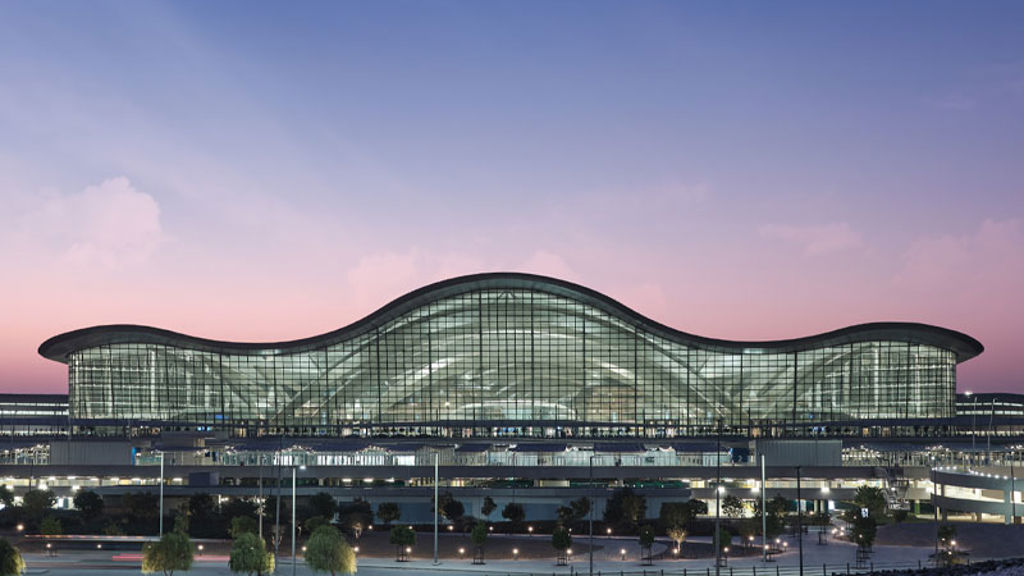
Transforming the travel experience at Zayed International Airport
Zayed International Airport Terminal A, United Arab Emirates

Crafting a New York–inspired atmosphere for passengers traveling through JFK’s global gateway to the world
JFK New Terminal One Art, Branding, and Digital Experience Program, United States of America
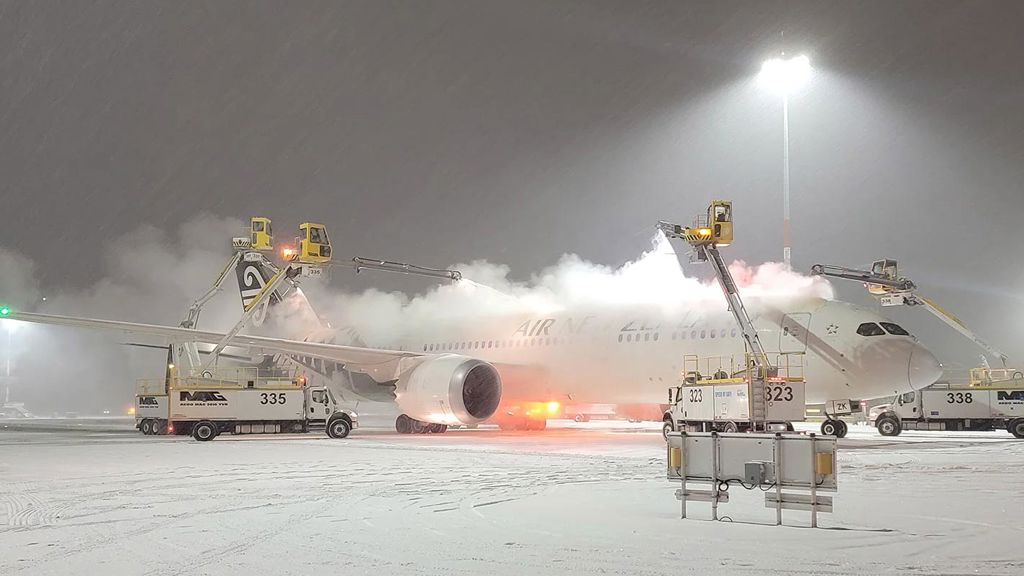
Helping Vancouver International Airport to prepare for unexpected weather
Vancouver International Airport After Action Review, Canada
Get in touch with us
If you'd like to speak to one of our aviation experts about any of the issues raised on this page or a potential collaboration then please get in touch by completing the form.
